We leave Stralsund the next morning in time for the 0820 opening of the Rügenbrücke, the bridge joining the island of Rügen to the mainland. We are one of the first through once it lifts. The wind is from the west and we have a pleasant broad reach down into the Greifswalder Bodden.

The First Mate’s phone pings. It’s a text from Bruderherz, her brother.
“You are going a bit slow”, it says. “That other boat has just passed you.”
He is watching us on MarineTraffic. Modern technology.
“It’s a bigger boat”, replies the First Mate. “And he’s got more sail area out than us.”
“Sounds like an excuse to me”, says Bruderherz.
We eventually arrive in Lauterbach. We tie up in the town harbour, and go and have a coffee.
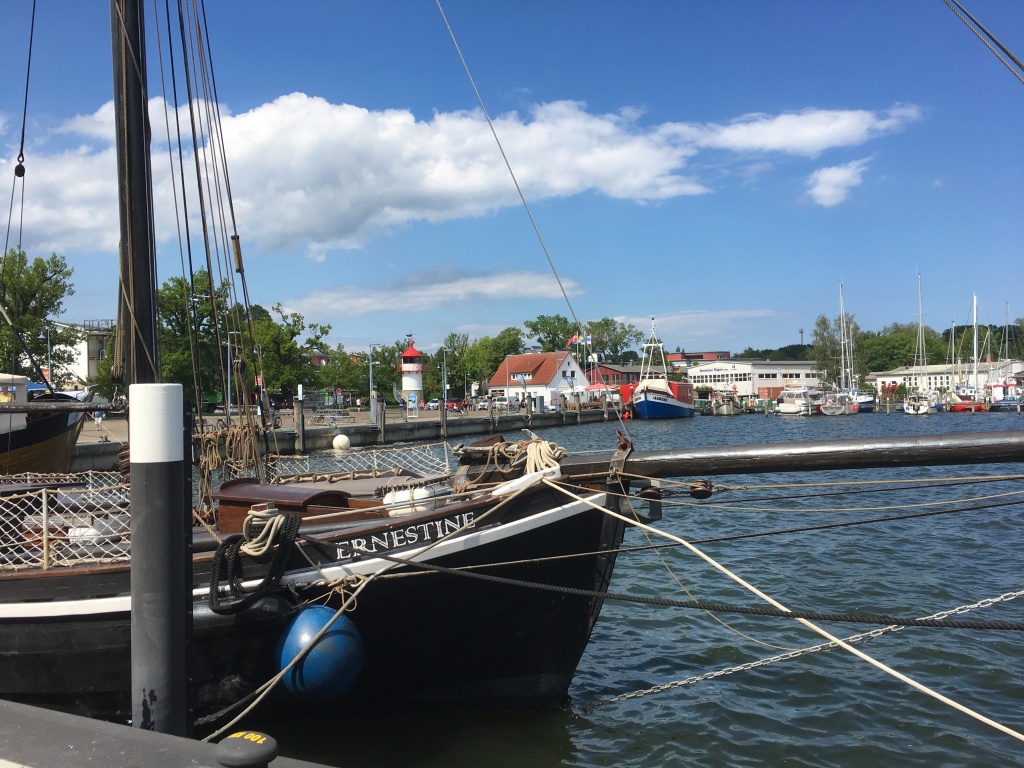
“You know”, says the First Mate. “I think we should move from the harbour around to the marina. There isn’t any wifi here and I want to download some movies. Their brochure says they have good wifi.”
We untie the lines and reverse out of the berth. There is a strong crosswind, and we somehow manage to catch the flagpole in one of the stern poles and break it. The second in less than a year. We clearly haven’t got the hang of box berths yet. At least not in cross winds.
“You just need more practice”, says the First Mate. “Preferably without the flagpole attached. Anyway, at least we will have wifi tonight.”
(Did you notice the ‘you’ when a mistake has been made?)
We motor around to the marina. The wind is stronger now and we struggle to stay straight for entering the berth. I have to abort twice before finally managing to get in without damaging anything.
“I definitely need a beer after that”, I say, wiping the sweat from my brow.
Silence. Only a keyboard being tapped furiously.
“I don’t seem to be able to get any wifi here either”, says the First Mate shortly. “What’s wrong with this place?”
“Yes, it isn’t very strong”, agrees the lady in the marina office. “Most people come and sit outside the office to use it.”
The ensuing storm clouds weren’t in the forecast. The lady looks a little perplexed as the First Mate gives her a lesson in truthful advertising.
We rig up an internet link through our phones instead.
“Well, I’ve booked them”, says the First Mate that evening. “We can travel on the buses and trains free for a month now. All for €9 each. Not bad, eh?”
She’s talking about the tickets you can buy for €9 a month which entitle you to free travel for that month on local buses and trains in Germany.
“There’s a little steam train for tourists that leaves from here and goes over to Göhren on the east coast of Rügen”, she continues. “I have checked and the €9 ticket is valid for it. It’s called Rasender Roland, or ‘Raging Roland’. Let’s go on it tomorrow. We can take the bikes and cycle back.”
In the morning, we cycle round to the little railway station at Lauterbach Mole. Sure enough, Rasender Roland arrives a few minutes later, puffing his way pompously to the buffers at the end of the line. I wonder where the raging bit comes from. A cloud of hot steam and coal smoke engulfs us.
“Mmmmm” I say. “I love that smell. It reminds me of when I was a kid.”
“Me too”, says the First Mate.
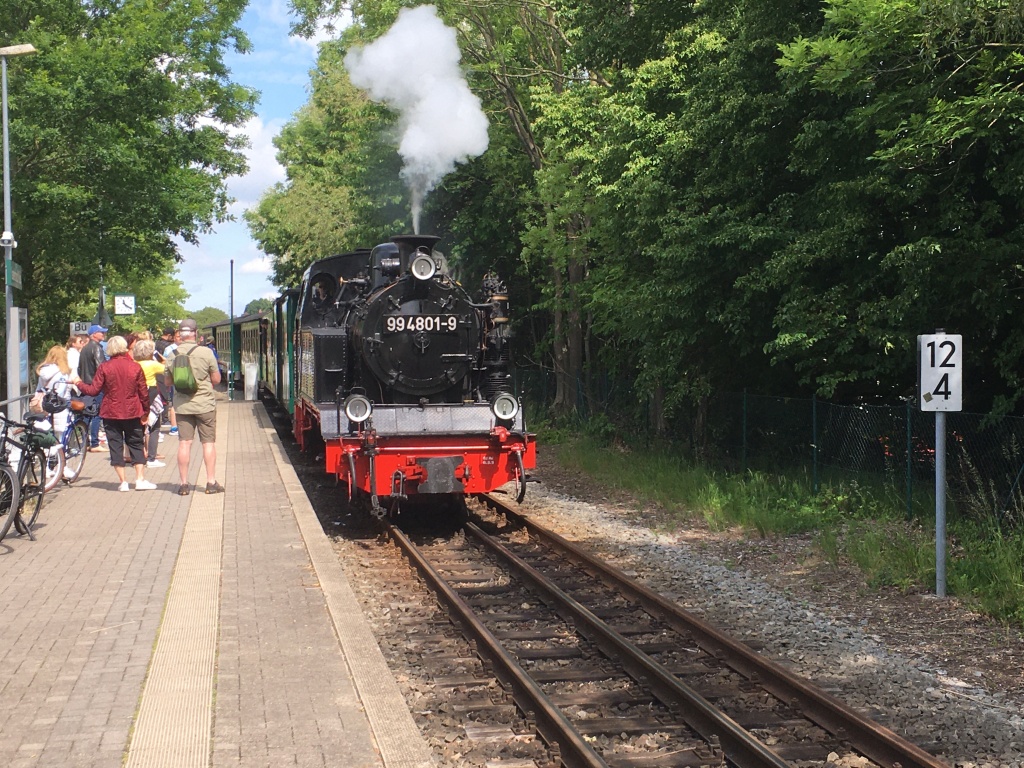
The narrow-gauge line started in 1895 and was originally part of a larger network over the whole island of Rügen. Gradually it has been reduced so that nowadays the only stretch that still runs is from Lauterbach to Göhren.
Our bikes are loaded into the guard’s van at the rear, and we find a seat in one of the carriages. The guard passes through the carriage taking a cursory glance at passenger smartphones and crumpled bits of paper.
“Well, that wasn’t very thorough”, I say. “He didn’t even look at mine. I could have had any old thing on my screen. I am surprised they don’t have to scan each ticket, even if it is only to know how many people are using the scheme.”
“I think they just assume that everyone has one of the €9 tickets”, says the First Mate. “Germans love a bargain, and it is almost unbelievable that anyone wouldn’t have it.”
We puff our way through the Rügen countryside full of fields of ripening barley, stopping at each small village with the clanking of brakes and hissing of steam. We start to climb through a heavily forested area, the sunlight blocked out by the dense canopy of trees.

Eventually we reach the eastern coast of Rügen and a series of bathing resorts one after the other. The end of the line is at Göhren, the southernmost of these.
“Let’s get some lunch here, have a look around, then we can start cycling back”, says the First Mate.
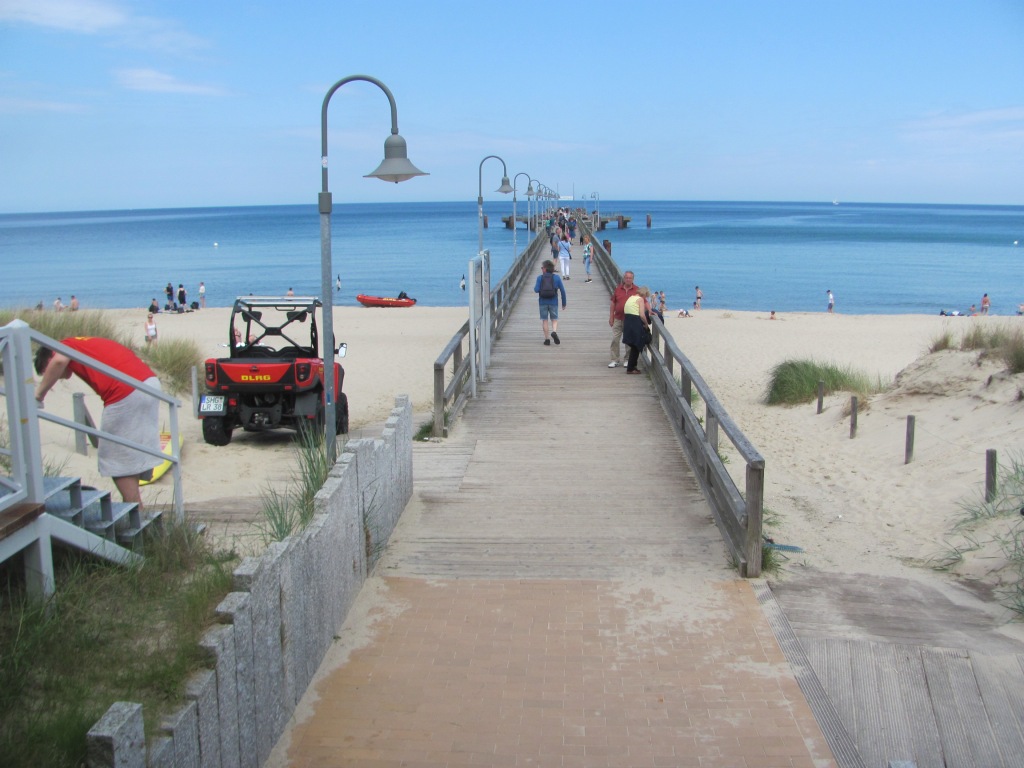
Replenished, we follow the cycle route signs. They take us to Baabe, then turn inland to the Selliner See. We arrive at Möritzdorf, a small village at the southern end of the See where its brackish water drains into the Greifswalder Boddin. Here we find a small rowing boat that is used to ferry people and bicycles from one side of the outlet to the other.
“Come on, hurry”, says the First Mate. “It’s just reaching our side at the moment. We can catch it.”
We wait until the arriving passengers disembark, then pass the bikes over to the ferryman and clamber on ourselves. A small dog remains in the boat.
“That’s Jackson”, says the ferryman. “He’s the boss. You need to do as he tells you.”
The First Mate sits down.
“Move over”, says Jackson gruffly. “That’s my side.”
The First Mate moves over. It occurs to me that she is never that obedient with me. Perhaps I need to bark more.
We reach the other side, clamber out, and unload the bikes.
“Zwei personen”, says the ferryman. “Zwei euros, bitte.”

We pedal our way along a small lane through rolling farmland to the top of a steep hill, then down again. At the bottom is a small village called Seedorf. We decide to stop for a drink of coffee and an ice-cream.
“This is a lovely little place”, says the First Mate. “So peaceful and quiet. Even a small harbour. Why don’t we bring Ruby Tuesday around here and chill out for a few days?”
“Sounds like a good idea”, I say.
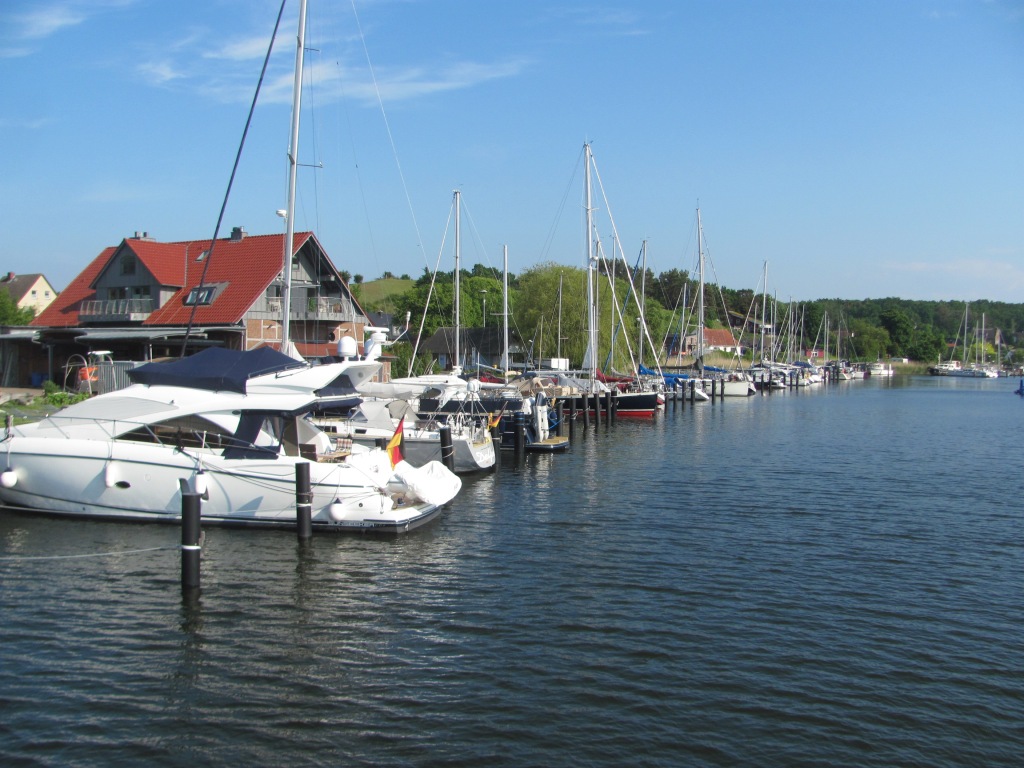
We continue on, passing through lush green woods, and delightful picturesque villages. Old ladies tend their gardens, old men their cows and sheep. It’s as if time has stood still.

“Look there’s a Trabant”, says the First Mate. “Do you remember that time we went to East Germany after the Wall came down? We were driving along a motorway and passed a Trabant that was struggling up a hill. I’ll never forget it – it had the mum and dad in the front, and two children in the back, all quite large people. The dad was hunched over the wheel urging it on as he was too tall to sit straight!”
“I remember it well”, I say.

The Trabant was another of the cars built in GDR times a bit like the IFA we had seen in Stralsund. It too had a two-stroke engine ranging from 500 cc up to 1100 cc, and was front-wheel drive. The body was made from a plastic derived from cotton waste. It was first manufactured in 1957 and remained pretty much the same until it was discontinued in the 1990s. Reliability was not one of its selling points.
“We used to say that it was a spark-plug with a roof”, says the First Mate.
“Do you know why they had heated rear windows?”, I ask, not to be outdone. “To keep the hands warm of the people pushing it to start it in winter.”
The old ones are the best ones.
The forest gives way to a coastal track before we arrive back in Lauterbach. A yacht is passing through the gap between Rügen and the small island of Vilm.
“We’ll be passing through there on the way to Seedorf in a couple of days”, I say.

The next morning, we catch Rasender Roland again, and get off at Binz. From there, we cycle north to Prora, where there are the remains of a vast sprawling complex built in Nazi times around the concept of Kraft durch Freude (Strength through Joy), or KdF.

Stretching 4.5 km along a beautiful sandy beach, and designed to cater for 20,000 people at a time, the complex was supposed to be part of the Nazi plan to prepare the workers’ mindset for war through judicious use of ideological indoctrination and unconditional belief in the Führer. As it turned out, WW2 interrupted its construction and it was never used for that purpose. But this didn’t stop KdF being highly influential in other areas of national life.

We spend a fascinating couple of hours browsing the exhibition in the Dokumentations Zentrum on the history of the complex and of Nazi Germany in general.

“I didn’t realise that the Nazis believed the island Rügen to be the spiritual home of the Germans”, says the First Mate. “The Germania that Tacitus wrote about.”
“It was all part of their propaganda”, I say. “They were really into ‘blut und boden’, the idea of a people being inextricably tied to the land, so they had to create a myth that the German people as a whole had an original homeland where they worshipped gods and goddesses in sacred groves and practised pagan rituals.”
“It is interesting how the whole KdF thing was all packaged up as ‘wholesome’ things – health, fitness, relaxation, community, patriotism and so on”, says the First Mate. “Boys were supposed to be strong and forceful, girls to be caring German mothers. I find it amazing how much people were influenced by it. I wonder if it could happen these days?”
It is happening these days, I think. We are all influenced by the media, politicians, our families, our peers, one way or another. We are told that leaving the EU would lead to sunlit uplands, the Americans are told that the election was stolen from the Republicans, the Russians are told that a war is necessary to ‘denazify’ a neighbouring country wanting to attack them. And a large number of people in the respective countries believe these things, despite all the evidence to the contrary, even to the point of taking pride in ignorance of the truth. Is there any such thing as truth anyway? You make your choice of a particular way of looking at the world, and you pick and choose the evidence that supports that narrative and ignore anything that doesn’t. We all do it. Are we really living in ‘post-truth’ times or has it always been like that?
“You are daydreaming again”, says the First Mate. ”Come on, let’s have some lunch. There’s supposed to be a café here somewhere.”

The next day we sail around to Seedorf, the picturesque little village we had cycled through earlier. It is very shallow, and there is a small sandbank at the entrance which we somehow manage to graze. In the evening, we have some drinks and listen to the prolific birdsong around the small harbour. A cuckoo calls.
“Did you know that Störtebeker was a famous pirate?”, says the First Mate, noticing my beer bottle. “It was one of the stories we had when we were growing up. He lived a way back in the 14th century and preyed on rich Hanseatic merchant ships, and became very rich. His name means ‘empty a mug of beer in one gulp’. Quite an impressive feat given that mugs were four litres in those days.”

“In the end, he was betrayed, captured, taken to Hamburg and beheaded. The story goes that he made a deal with the mayor of Hamburg that he should spare as many of his men as he could walk past after he was beheaded. Apparently he managed to walk headless past eleven of his men before falling over, but the mayor wasn’t impressed and beheaded them anyway.”
“That was quite an achievement of Störtebeker’s”, I say. “But a bit dishonourable on the part of the mayor. Well, I’ve finished my beer, but not in one gulp though. And not four litres either.”
“Don’t apply for a job as a pirate then”, says the First Mate.
In the morning, we sit in the cockpit and have our breakfast, listening to the cuckoo.
“I think I would like to see the Jagdschloss today”, I say. “Since we have been here, I have been intrigued by that tower up there poking out of the forest. Fancy coming?”
“You won’t be happy until you have been up to see it”, says the First Mate. “Why don’t you cycle up there this morning? I think I might take the bus up to Bergen in the centre of the island and do some browsing. You can tell me all about it tonight.”
It is a pleasant cycle ride around a brackish lagoon and barley fields until the last bit, a steep hill where the road is cobblestones and potholes. I push the bike up that last bit to protect the wheels. At least that’s what I tell myself. In reality it is my knees.

The Jagdschloss is an old hunting lodge built by the local Prince Wilhelm Malte I of Putbus back in the mid-1800s. By all accounts he was pretty well connected, and all sorts of the Prussian nobility attended hunts at the castle and the banquets afterwards. Friedrich Wilhelm IV of Prussia and Otto von Bismark were amongst the guests.
In 1865, the Prince’s main palace at Putbus had been badly damaged by a fire, despite desperate attempts by the villagers to save it. While it was being rebuilt, he and his family moved into the hunting lodge, and lived there for 17 years. It must have been tough for them. The Palace itself was eventually blown up by the GDR regime who saw it is a relic of decadent Prussian imperialism.
In 1944, ownership of the hunting lodge was taken over by the Nazis for the Prince of Putbus’s alleged involvement in the plot to assassinate Hitler. Nowadays it is still owned by the state, but is used as a museum.
Two hunting dogs guard the entrance. Inside, the walls are adorned with antlers and other trophies, and photographs of hunting. Although most of the original furnishings disappeared during GDR times, a restoration in 2014 gives a flavour of aristocratic life in those times. Prussian aristocracy certainly knew how to live.

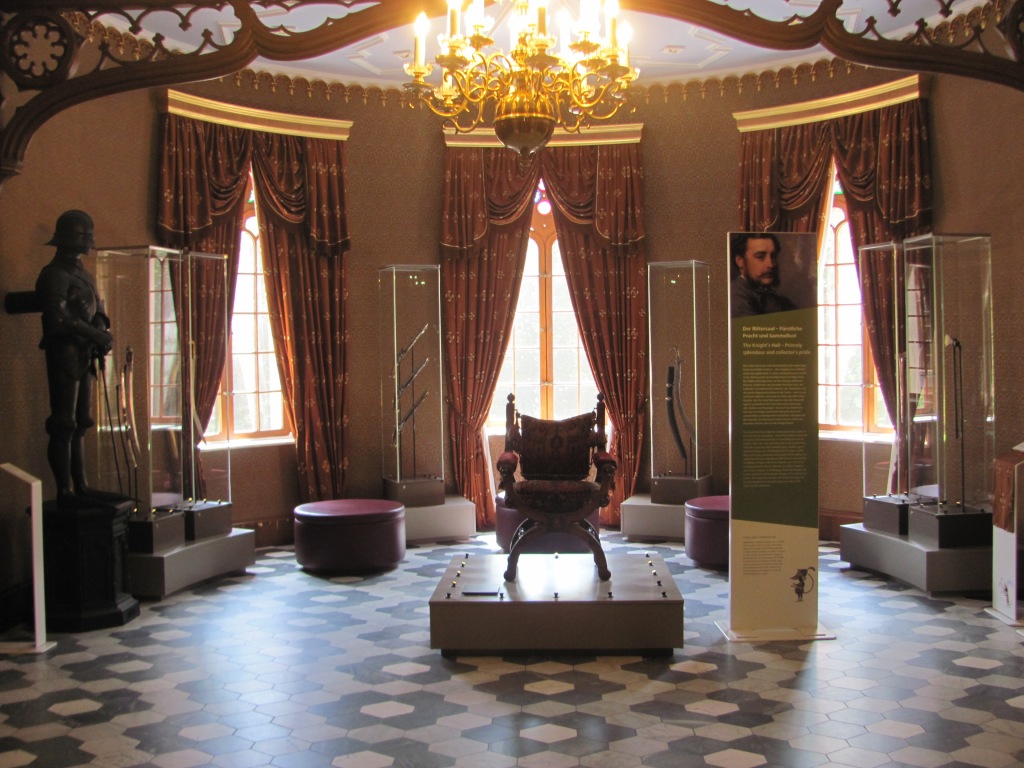
The stairs to the tower are cantilevered, entirely supported by its walls. I was getting used to climbing towers by this stage, and after the 90 m tower of St Mary’s church in Stralsund, this one is a doddle. Once again, though, the view was superb, from Sassnitz in the north of Rügen right down to Usedom. Below me lie the forests of Granitz.


“Well, Bergen wasn’t that interesting”, says the First Mate that evening. “How was the Jagdschloss?”
I tell her.
“What a shame the GDR people destroyed the palace!”, she exclaims when I get to that bit. “Vandals.”
It chimes with the current debate about whether monuments from a previous era should be destroyed if they don’t match current ideology. The Taliban destroyed the Buddhas of Bamiyan in 2001 because they weren’t the right religion. Statues of people benefiting from the slave trade have been pulled down. This Putbus palace was blown up because it didn’t fit with communist ideology. But destruction doesn’t seem to be the answer. We somehow need to find a way of preserving works of art and culture without offending living people’s sensitivities.
“Have you noticed that the water here tastes a bit strange?”, I say the next morning. “My Earl Grey this morning was almost undrinkable. Sort of an acidic taste.”
“Oh, no”, says the First Mate. “I put some vinegar in the kettle last night to descale it and forgot to mention it to you. I am so sorry.”
“Cuck-oo, Cuck-oo”, says the cuckoo.

Another fascinating and enjoyable blog! And the Internet troubles are all too true!
LikeLike
Thanks Birgitta. We have found that marina wifis in this part of Germany are VERY slow. Even 4G on our phones as hotspots is painful sometimes. Not sure why.
LikeLike
It is surprising isn’t it, how bad it can be near land and out at sea (not too far out!) there’s no stopping what you can do!
LikeLike